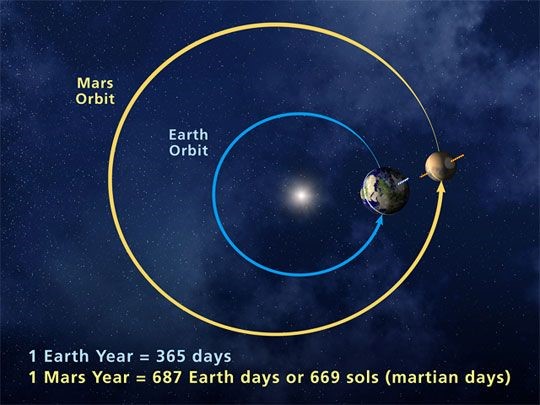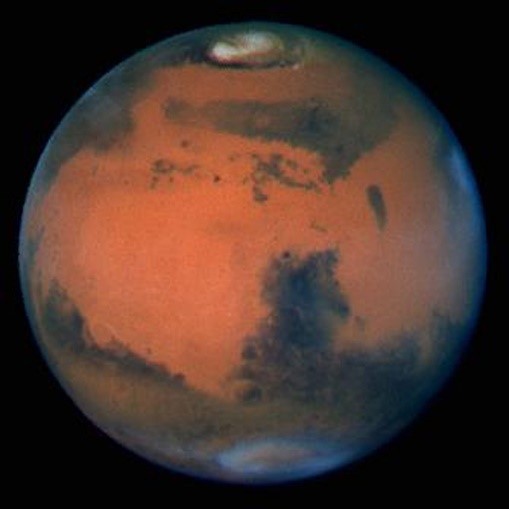This year is a great one for Mars, and September is the month in which it starts to stand out, becoming much brighter and also visible at more convenient hours. As can be seen from the table below, based upon information from NASA, all of the planets have oval orbits around the Sun (ellipses), not perfect circles. Mars has one of the most eccentric of these orbits. All distances are shown in millions of miles.
| Planet | Closest Distance To Sun |
Farthest Distance From Sun |
Closest Distance To Earth |
Farthest Distance From Earth |
| Earth | 91 | 94 | ----- | ---- |
| Mars | 128 | 155 | 34 | 249 |

Note how Mars appears opposite the Sun in the sky when it is closest to Earth. Every 26 months, the Earth passes Mars relative to the Sun. If opposition happens at the time when Mars is also near its closest point to the Sun, it is particularly bright in the sky. This year’s opposition takes place on October 13 and is considered to be the best one between 2003-2035. (Courtesy NASA)
All of this means that at closest approach, Mars is more than seven times closer to us and shines nearly sixty times brighter than it does at its greatest distance. This variation is much more noticeable than for any of the other planets. Venus and Mercury also vary a lot, but their orbits are closer to the Sun than Earth’s orbit is. At their closest to Earth, their lit sides face the Sun and dark sides face the Earth, cancelling out much of the change. You can also interpolate from the image and determine that on average, Earth passes Mars about once every 780 days, or nearly two years and two months. These passes are called oppositions of Mars, as Earth passes between Mars and the Sun, causing Mars to appear opposite the Sun in the sky and thus visible all night long. These passes are not all created equal- you can see that at the best possible opposition, Mars could be 34 million miles from Earth, while at the worst one, it could be 64 million miles away. With all these changes, Mars is certainly the most interesting planet to see with the unaided eye or in binoculars.
2020 marks a very good opposition of Mars, with a minimum distance from Earth of about 38.6 million miles on October 6. This is not quite as close as back in 2018 but Mars will stand much higher in the sky this time, making this year the best appearance of Mars until 2035, at least for the northern hemisphere of Earth. Being so bright and near, Mars is very easy to find in the sky. At the beginning of September, it rises just north of due east, at about 9:40 pm St. Louis time, improving to 7:35 pm on October 1. At opposition on October 13, it will rise at sunset and set at sunrise. Depending upon how open your view is at the horizon and the clarity of the night, it may take an hour or so after that time for Mars to clear the houses, trees, and haze to appear fully bright. Also notice Jupiter and Saturn, the two bright “stars” side by side about one third of the way up in the southern sky in the early evening these September nights. Mars will double its brightness during September, matching or even slightly exceeding Jupiter’s brightness from late September-late October, a rare occurrence. To make it even easier, the Moon will pass close by Mars on the nights of September 5, October 2, 29, and November 25. After its close approach this fall, Mars can be followed in the evening sky all though the winter and spring into early next summer, still notable due to its reddish orange hue, but gradually dwindling away to become no brighter than some of the stars in the Big Dipper.
Another thing you can look for over the next couple months is Mars’ retrograde motion. Normally, planets move around the Sun from west to east. If you look closely at their positions relative to nearby stars in the sky, you may see a change over time. However, when Earth passes Mars (or any of the outer planets), they appear to slow down, pause, and then move backwards from east to west for a month or two. Jupiter and Saturn went through this earlier this summer- see my July blog entry for details. Unfortunately, Mars is seen this year in front of the dim stars of the constellation Pisces, so you will need binoculars or dark country skies to see it retrograde this year. It should be at its stationary point near mid-September, move slowly westward, and then pause again in mid-November.
Mars is a small planet, just over half the size of the Earth, and has a thin atmosphere mostly of carbon dioxide. There aren’t many clouds to block the view, and Mars’ bare, sandy surface shines a reddish-orange color. With a good telescope, white polar caps and dark albedo features can be seen on Mars, although not nearly as well as with the Hubble Space Telescope image below (courtesy NASA). Nineteenth and twentieth century astronomers correctly identified the polar caps as ice, but they first thought the dark features were lakes and vegetation. Giovanni Schiaparelli thought he could glimpse dark lines connecting some of the markings, naming them “canali” (channels in Italian). This was mis-translated into English as “canals.” Several astronomers, the most famous of which was Percival Lowell, and theorized the existence of an advanced Martian civilization who built the canals. This idea got some support because it was noticed that the features tended to get darker in Martian spring and summer, exactly as vegetation would. As is well known, all of this came to public notice and was popularized in science fiction, with the most notorious event being the panic caused by the 1938 broadcast of War of the Worlds.

Mars as imaged by the Hubble Space Telescope. The polar ice cap appears at the top, with various albedo features scattered around the disk of the planet. Once thought to be areas of water or vegetation, these darker areas were revealed by NASA spacecraft to be simply darker rock, seen through varying degrees of Martian dust. Occasional dust storms can obliterate almost all detail seen on Mars and can affect spacecraft on the surface by covering their solar panels. This caused the death of the Opportunity Mars Rover. (Courtesy NASA)
In retrospect, it is easy to shake one’s head at how far off from reality all of this was. Even at its closest this October, you will have to magnify Mars about eighty times in a telescope just to make it appear as large as the Full Moon does to the unaided eye. But if you put yourself in the shoes of Schiaparelli, Lowell, and other astronomers, it is somewhat understandable how you could jump to wild conclusions. High level observing means gazing with teary, imperfect eyes through imperfect telescopes, at tiny features on an already small object, and amidst the shimmering and blurriness caused by Earth’s atmosphere. Under these conditions, it is possible to connect barely seen dark spots into lines, and lines into complicated networks, all the more so if you are expecting to see something based upon the reports of others.
An increasing number of experts were skeptical about these ideas by the 1950s, realizing that the very cold temperatures and thin atmosphere of Mars, containing very little oxygen, made advanced life unlikely. This was confirmed by the spacecraft that arrived at Mars beginning in the 1960s. The albedo features were shown to merely be areas of darker rock that were made more or less visible by shifting dust on Mars, and definitely not lakes, large areas of vegetation or alien-made canals. Microbial life could have begun on the planet, and just possibly could still exist. With Mars close this year, spacecraft from the United States, China, and the United Arab Emirates are currently on the way to Mars, joining those already orbiting or on the surface. One of the great things about astronomy and stargazing is that you can take it at so many different levels, ranging from the advanced chemistry, physics, and biology involved in the search for extraterrestrial life to simply marveling at the motion and brightness of objects like Mars in the sky, this year putting on its own great show.
Don’t miss the September 26 edition of our Gateway to the Stars program. At 6:30 pm, Lights Out: Heartland will focus upon the impact of light pollution upon birds, ecosystems, and stargazing. Guests from Audubon societies, Dark Sky Missouri, and other organizations will engage in an online panel discussion. This will be followed at 7:30 pm by Virtual Stargazing at the Gateway Arch, featuring a tour of the night skies using the Stellarium program and images transmitted by local amateur astronomers from the St. Louis Astronomical Society. View the Gateway Arch NPS Facebook Page for information on how to see this and other park programs.
